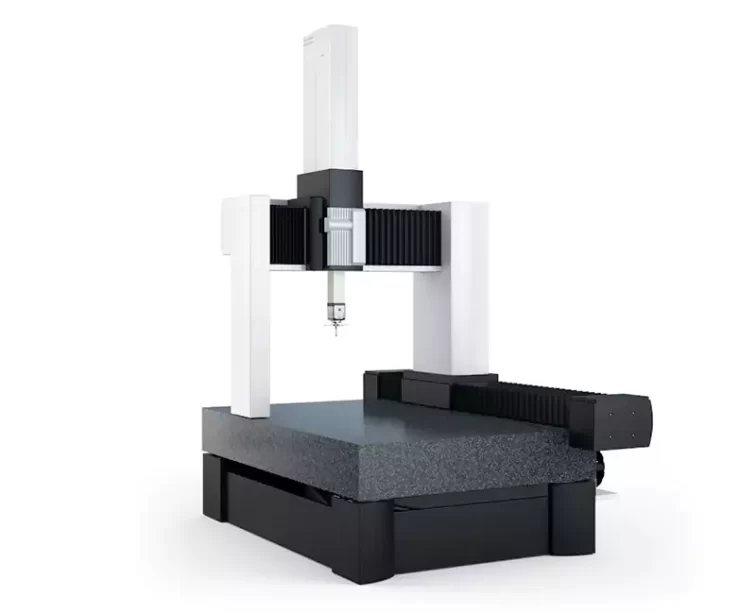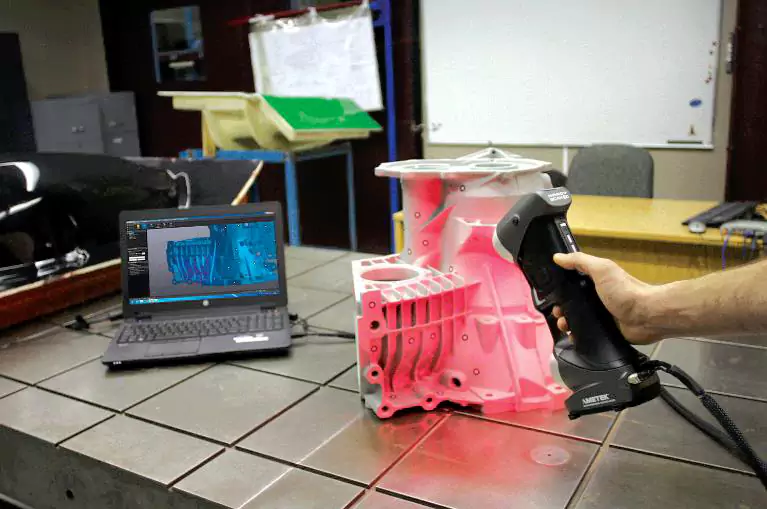All You Need to Know About CMM Machines
What Is a CMM Machine?

A Coordinate Measuring Machine (CMM), also known as a CMM, is an apparatus designed to measure the geometries of physical objects. CMMs employ a probing system to detect individual points on object surfaces.
The first-ever CMM made its debut in the early 1960s. Initially developed by the Ferranti Company in Scotland during the 1950s, this two-axis CMM utilized a 3D tracing device with a basic digital readout that displayed XYZ positions. Ferranti utilized their CMM to measure precision components for military products. In the later 1960s, three-axis models were introduced.
CMMs are primarily used to test parts or assemblies and determine if they conform to the original design specifications. They are integrated into quality assurance or quality control workflows to inspect the dimensions of manufactured components, thereby preventing or resolving quality issues.
Using CMMs offers several advantages over conventional measuring tools with manual inspections or traditional metrology instruments like micrometers and height gauges. These advantages include increased accuracy, speed, and a reduction in human errors.
There are various types of CMMs, typically categorized based on their structures. Each structure has its own advantages and disadvantages. Now, let’s delve into the different types of CMMs in more detail.
Importance of CMM in Various Industries
The importance of Coordinate Measuring Machines (CMMs) can be summarized as follows:
Accuracy and Precision
CMMs offer high levels of accuracy and precision in dimensional measurement. They can measure complex geometries and critical features with great detail, ensuring that components and products meet strict tolerances and specifications. This accuracy is vital in industries where precision is crucial, such as aerospace, automotive, and medical.
Quality Assurance
CMMs play a significant role in quality assurance by inspecting and verifying the quality of manufactured parts and components. They help identify any deviations or variations from the intended design, enabling manufacturers to take corrective actions and maintain consistent quality throughout the production process. This ensures that only conforming products reach the market, enhancing customer satisfaction and brand reputation.
Process Control
CMMs aid in process control by providing real-time feedback on the manufacturing processes. By measuring and analyzing dimensional data, CMMs can detect any trends, variations, or anomalies in the production process. This information allows manufacturers to make timely adjustments, optimize processes, and prevent the production of defective parts, reducing scrap and rework.
Time and Cost Savings
CMMs offer efficient and rapid measurement capabilities, significantly reducing inspection time compared to manual measurement methods. They automate the measurement process and provide accurate results quickly, saving time and labor costs. Moreover, by detecting and addressing quality issues early in the production cycle, CMMs help prevent costly rework, recalls, and customer complaints.
Design Verification and Reverse Engineering

CMMs are instrumental in design verification and reverse engineering processes. They can compare measured data against CAD (Computer-Aided Design) models, ensuring that the manufactured components align with the intended design. CMMs also enable reverse engineering by capturing the physical dimensions of existing parts and creating CAD models, facilitating product improvement, and innovation.
Compliance with Standards and Regulations
Industries such as aerospace, automotive, and medical have stringent standards and regulations that must be met to ensure safety, reliability, and regulatory compliance. CMMs assist in verifying compliance by accurately measuring and inspecting components, ensuring they adhere to the required standards and regulations.
How CMM Works
CMMs are commonly used in industries such as automotive, aerospace, and precision engineering. Here’s an overview of how CMM works:
Structure
A CMM consists of three main components: the machine structure, the probing system, and the control system. The machine structure typically has a granite or aluminum base with three orthogonal axes (X, Y, and Z) for movement. The probing system includes a probe or a touch-trigger mechanism for taking measurements. The control system manages the overall operation of the CMM.
Calibration
Before measurements can be taken, the CMM needs to be calibrated. This involves determining the relationship between the movement of the machine’s axes and the corresponding displacements in the probe’s position. Calibration ensures accurate measurements by compensating for any errors or inaccuracies in the system.
Programming
Once calibrated, the CMM needs a measurement program to follow. This program specifies the desired measurement points and the corresponding paths the probe should follow to acquire those points. Programming can be done using specialized metrology software that allows the user to define measurement features, tolerances, and other parameters.
Measurement
With the program set, the CMM starts the measurement process. The CMM machine moves the probe along the programmed paths and makes contact with the object being measured. There are different types of probes available, including touch-trigger probes and continuous contact probes. The probe collects position data, and the CMM records the coordinates of the measured points relative to its own reference system.
Data Analysis
After collecting the measurement data, the CMM performs data analysis. The metrology software processes the coordinate information obtained from the probe and compares it to the expected dimensions and tolerances. It calculates deviations, distances, angles, and other dimensional characteristics of the measured object. The software can generate reports, graphical representations, and statistical analyses of the measured features.
Inspection and Quality Control
CMMs are commonly used for inspection and quality control purposes. The measured data is compared against the design specifications to ensure that the manufactured object meets the required standards. Deviations and variations can be identified, allowing manufacturers to make adjustments and improvements in their production processes.
Overall, CMMs provide precise and accurate measurements of complex parts and components. They offer a reliable means of quality assurance, dimensional analysis, and reverse engineering in various industries.
Types of Coordinate Measuring Machines
There are several types of Coordinate Measuring Machines (CMMs), each designed to suit specific measurement requirements and applications. The main types of CMMs are as follows:
Bridge CMM
Bridge CMMs utilize a probing system that operates across three orthogonal axes: X, Y, and Z. These axes correspond to a Cartesian coordinate system and enable precise movement along different directions. Each axis is equipped with a sensor that tracks the position of the probe as it traverses the object being measured.
By detecting specific points on the object’s surface, a collection of these points, known as a point cloud, is generated. This point cloud provides a visual representation of the desired surface area for inspection. Bridge CMMs can be categorized into two sub-types: moveable-table and moveable-bridge CMMs, based on the particular arrangement of the machine’s components.
Cantilever CMM
In a cantilever CMM, the horizontal arm extends from a fixed base, and the measuring probe is mounted at the end of the arm. The arm moves along the X-axis, while the workpiece is placed on a separate table. Cantilever CMMs are suitable for measuring larger workpieces that require a greater reach.
Gantry CMM
Gantry CMMs share similarities with bridge CMMs, but they are typically larger in size. They are specifically designed to eliminate the requirement of lifting a part onto a table during measurement. Offering comparable levels of accuracy to bridge CMMs, Gantry CMMs are commonly employed for inspecting heavy or oversized components. To ensure stability, Gantry CMMs must be securely mounted on a robust foundation directly on the floor.
Portable CMM
Portable CMMs are lightweight and portable devices that can be taken to the location of the workpiece. They typically consist of a measuring arm with articulating joints and a touch probe. Portable CMMs are useful for on-site inspections, measuring large objects, and areas where it is not feasible to bring the workpiece to a fixed CMM.
Optical CMM
Optical CMMs utilize non-contact optical sensors, such as vision systems or laser scanners, to capture 3D measurements of the workpiece. These systems project structured light or capture images, and advanced software algorithms analyze the data to generate precise measurements. Optical CMMs are suitable for delicate or sensitive surfaces and can capture large amounts of data quickly.
Conclusion
The Coordinate Measuring Machine (CMM) is a valuable tool used for measuring the physical and geometric properties of machine parts. Understanding the functionality of a CMM machine is essential, but integrating it seamlessly into the manufacturing process can be challenging. One effective approach is to outsource these services, and when it comes to outsourcing, Capable Machining is your ideal choice.
We provide access to a reliable coordinate measuring machine, allowing us to deliver comprehensive dimensional reports and ensure quality assurance. Whether you require dimensional analysis for a single machine part or a combination of manufacturing processes like CNC machining, injection molding, or 3D printing, we’ve got you covered. With CapableMachining, you can benefit from our convenient online quotation system, short lead times, and competitive pricing.